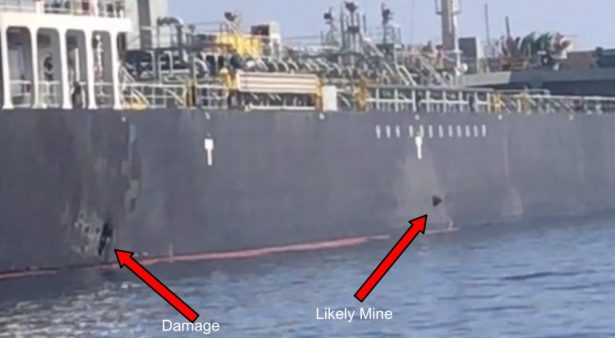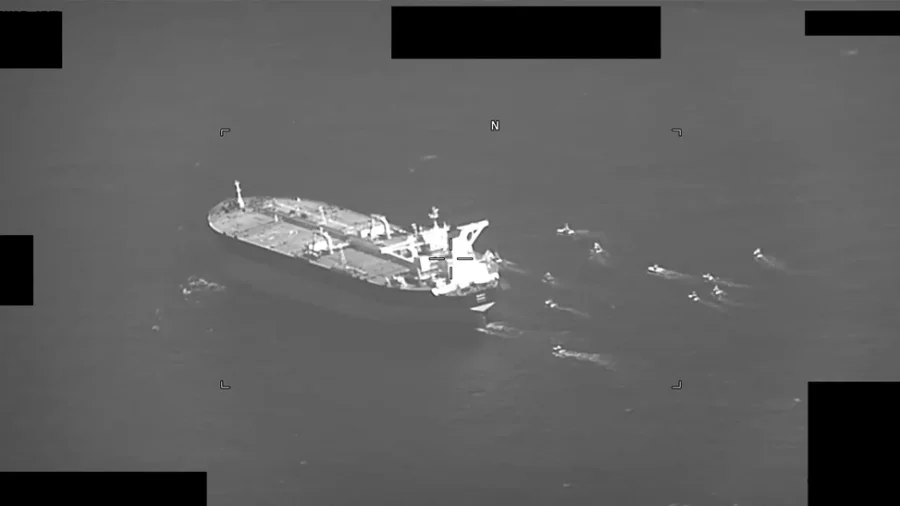Iranian forces have seized a second oil tanker in a week, U.S. Navy reported, after a Panama-flagged oil tanker was captured on Wednesday in the Strait of Hormuz.
The Navy’s Bahrain-based 5th Fleet identified the ship as the Niovi, a crude oil tanker with a freight capacity of 300,000 metric tons.
The tanker had left Dubai on Tuesday on its way to the port of Fujairah, a major oil hub in the area. Early next morning, at approximately 6:20 a.m. local time, Iran’s Islamic Revolutionary Guard Corps Navy (IRGCN) attacked the vessel.
A video released by the U.S. Navy shows about a dozen IRGCN fast-attack craft swarming the vessel in the middle of the strait.
The IRGCN then “forced the oil tanker to reverse course and head toward Iranian territorial waters off the coast of Bandar ‘Abbas, Iran,” the Navy said.
“Iran’s actions are contrary to international law and disruptive to regional security and stability,” the 5th Fleet said in a statement. “Iran’s continued harassment of vessels and interference with navigational rights in regional waters are unwarranted, irresponsible and a present threat to maritime security and the global economy.”
Iran did not immediately acknowledge the seizure.
Vessel Seized in Gulf of Oman
On Saturday, Iran seized a Marshall Islands-flagged vessel in the Gulf of Oman called the Advantage Sweet, a 159,000-ton capacity tanker carrying a shipment of crude oil for Chevron.
The IRGCN boarded the ship via helicopter and forced it to dock in Bandar ‘Abbas.
In the preceding weeks, the United States has enacted various punishments against Iran over various issues, including its violent crackdown on protests, drone sales to Russia, and the long-standing matter of its ongoing nuclear weapons development program.
Sanctions included visa restrictions on Iranian officials over alleged human rights abuses in Iran and the confiscation of a shipment of Iranian oil on a 158,000-ton capacity tanker, the Suez Rajan, in a sanctions enforcement operation.
Iran’s attacks on commercial vessels in the Gulf waters began after the United States withdrew from Iran’s nuclear deal and have since flared up in times of tension between the two nations.
British-Linked Tankers
In July 2019, two British-linked tankers were seized in the Strait of Hormuz, the Stena Impero and the MV Mesdar. The Stena Impero was released in September 2019.
Additionally, a series of limpet mine attacks damaged tankers in 2019, which the U.S. Navy has blamed on Iran.

In 2021, a fatal drone attack occurred on an Israeli-linked oil tanker, killing two crew members.
In May 2022, Iran’s Revolutionary Guard, designated a terrorist group by the United States, seized two Greek tankers in the Persian Gulf. Iran released the tankers in November.
According to data analytics firm Vortexa, about a fifth of the world’s oil products passes through the narrow Strait of Hormuz. In 2020, Vortexa warned that further disruption “could impact not only Mideast Gulf crude oil exports to global customers, but also the established flow of refined products to world markets.”
A continued disruption would disproportionately impact the Asia-Pacific region, especially South Korea and Japan, and to a lesser degree, China and India.

